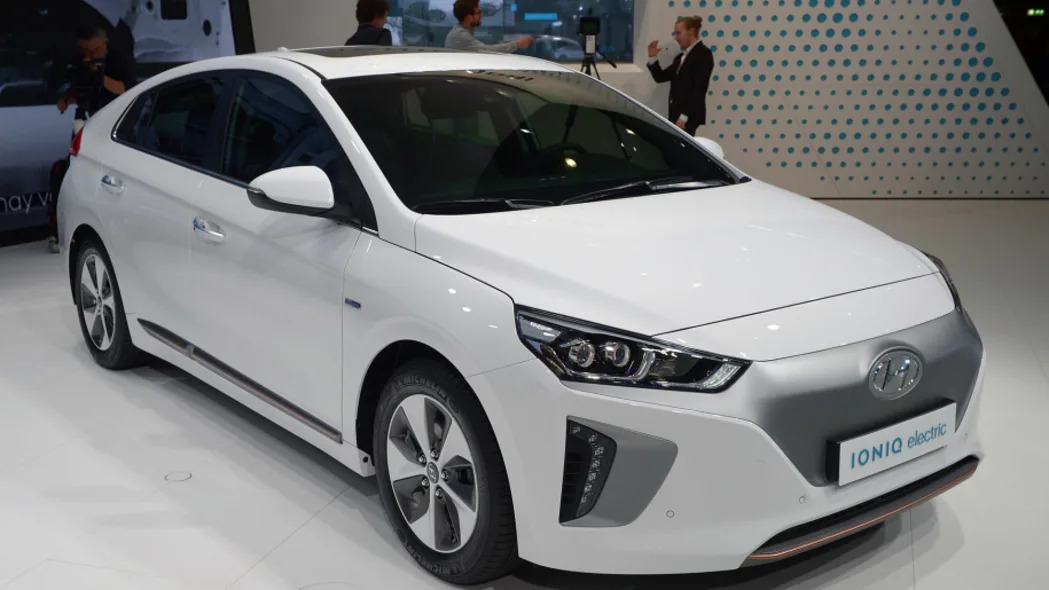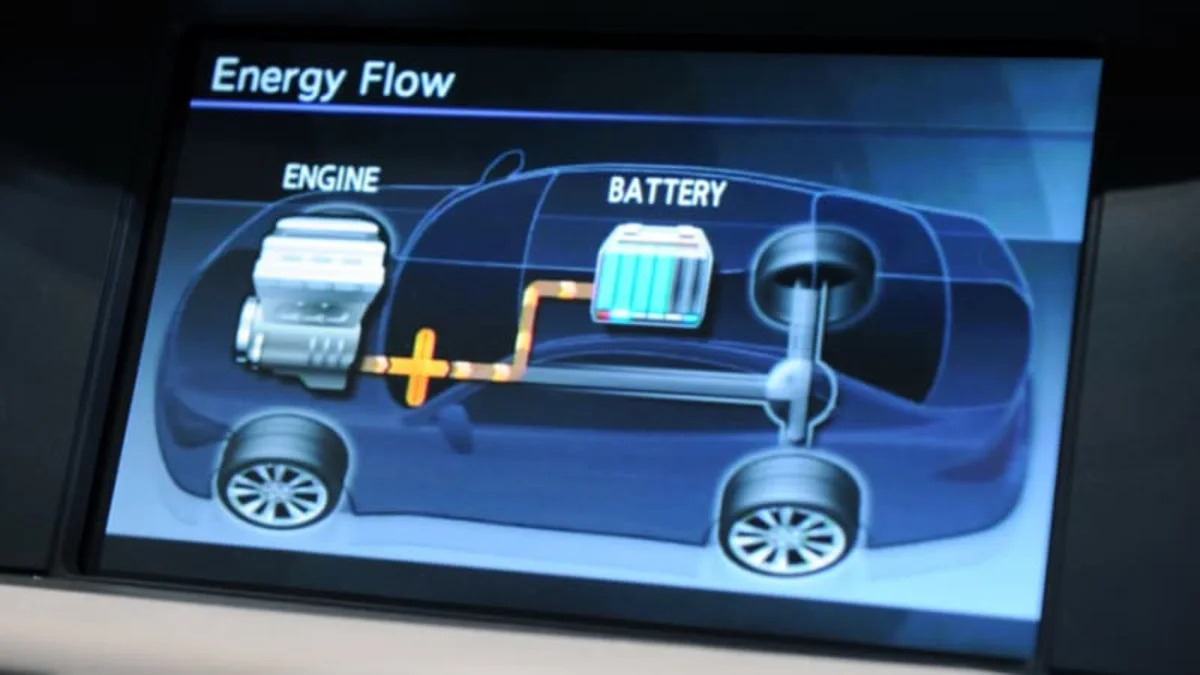If you're shopping for a new vehicle these days, there's a litany of acronyms, buzzwords, and technobabble to further complicate an already difficult decision. But if you're looking at a green powertrain, you have three basic choices to compare: hybrid, plug-in hybrid and "EV" or, electric vehicle.
So what are they and which one — if any — is right for you?
Research your next new vehicle using Autoblog's Car Finder.

Gasoline-Electric Hybrids
By now, most people are familiar with the concept of a hybrid car. Thank Toyota's Prius for that. At its most basic, a hybrid vehicle has two powertrains, one gasoline and one electric, which work together for maximum efficiency. At low speeds, the engine can shut off entirely, relying solely on the battery for propulsion. The battery is either charged as you drive by converting kinetic energy into potential energy via a complex regenerative braking system, or directly off of the gas motor. This is a very hands-off, behind-the-scenes system as all the driver has to is put in gas and drive as normal.
Hybrids come in all shapes and sizes and, according to the EPA, range in fuel economy from 58 mpg for the Hyundai Ioniq Blue all the way down to 13 mpg for the Ferrari LaFerrari Aperta.Best For: Anyone who want to see their fuel consumption go down without many sacrifices. You can easily find a hybrid sedan, hatchback, crossover, SUV or even a pickup truck (i f you can find one). Best of all, a hybrid requires no special equipment to be installed at home, or added work for the driver. Hybrids do cost more than traditionally-powered competitors, so make sure to compare projected fuel savings with how much extra a hybrid will cost – it may take a surprisingly long time to break even. The EPA provides a handy calculator for this very purpose.
Our Favorite Hybrids:

Plug-In Hybrids
Sometimes referred to as a PHEV, or plug-in hybrid electric vehicle, this is a baby-step towards full electrification. Armed with a much larger battery pack than a hybrid, PHEVs can go between 12 ( Mercedes-Benz GLE550e) and 97 ( BMW i3 w/Range Extender) miles on electricity alone depending on the model and your driving style. Like a normal hybrid, the driver is largely unaware of which power source is currently in use, even as they switch over — either because the battery is drained, or the driving circumstances require more power. Once the battery is drained, they drive like a conventional hybrid (albeit with a smaller battery).
PHEV's, however, do require some effort on the part of the driver; as the name implies, for optimum performance and fuel economy, they need to have a full battery when you start driving to get maximum EV range, and that means you'll want to plug it in to recharge. And due to the relatively short range, they should be plugged in to special high-powered wall-chargers daily. More on that at the end of this article.
Best For: People with short commutes that can take advantage of the EV-only capabilities, who have access to a charger, but who might occasionally need to exceed the range of a traditional EV.
The real beauty of the PHEV is the flexibility. Depending on your commute, driving style and the PHEV chosen, it's possible you'll only visit the gas station when taking a longer trip. Take the Chevy Volt for example. With a fully-charged battery, the Volt can go 53 miles on a charge. That's enough for most Americans' commutes. With a fully-charged battery and a full tank of gas the Volt will go 420 miles. Think that's impressive? When all full of electrons and fuels, the Chrysler Pacifica PHEV can go 570 miles.
PHEV's are also recommended for people who enjoy a bit of gamification in their driving. Beating EPA estimates and hypermiling in PHEV is easy and, frankly, fun. And because of the brake regen, you don't even have to drive slowly to achieve this.
Our Favorite Plug-in Hybrids:

Battery-Electric Vehicles
EV's represent the final, most aggressive change to the way Americans tend to drive. As the name implies, these vehicles are fully electric. No gasoline at all. Even as a backup. New EVs on sale today have EPA-estimated ranges between 57 (Smart ForTwo ED) and 335 (Tesla Model S P100D) miles with most falling somewhere around 100 miles.
Driving an EV is different than driving a traditional car, or either of the types above. Electric powertrains can strongly accelerate from a complete stop, but when you let off the accelerator there's a strong decelerative effect as the EV harvests energy from your forward motion – a process called regeneration. With some EVs, you can drive in most situations without touching the brake pedal, using the accelerator and releasing it for strong regenerative "braking". It's bizarre at first, but a shocking amount of fun once you get used to it.
Best For: Early adopters who have access to a high-powered charger, a short commute, and a solid grasp of how far and how often they drive. These cars requires a level of thought and preparation most people aren't used to, and while it's easy to think that these are exclusively for urban use, with some care and a careful purchase, an EV could be a fine suburban family vehicle. Or, a second vehicle to complement a longer-range gas car or truck.
Again, we'll repeat that you need to know your habits, preferences and ecosystem before taking the leap to full electrification. Unlike a PHEV, if you run down the battery in a full EV, there's nothing to save you except a tow truck. Further, where you live can have a severe impact on the performance of an electric car. Highway driving, cold weather and grades can all negatively impact estimated EV range in a dramatic fashion. So can your driving habits. In a "normal" car, this means you hit the gas station sooner. In an EV, it means you can't make that side-trip to the beach without doing a little mental mileage math.
Our Favorite EVs:

Special Equipment and Procedures
Chargers: During this article we mention charging a number of times and it's worth taking a moment to discuss that aspect of EV and PHEV life. While you can simply plug these cars into a standard household wall charger – known as a Level 1 or 120V charger – using the adapter that came with the car, it would take a frustrating amount of time. Figure approximately 4 miles of range per hour. That's 13.5 hours to get the 53 miles back on your Volt.
Level 2 chargers use the same 240V systems as your dryer and require professional installation. Depending on the model of charger, its max amperage (more = faster charger), your home circuitry and the vehicle, these generally offer around 20 miles of charge per hour. When mounted in your garage, it's an easy habit to just plug in the car each night and wake up to a fully-charged car.
Finally DC fast chargers are industrial-level applications you'll find at your local EV dealer or at public charging stations. There are three separate types of DC fast charger and knowing which your car has is important when looking for public fast charging. Think about the EV charging parking spots you may have seen in public garages, or the Tesla Supercharger stations.

The best choice for most people is a home charger. Your car is already dormant for hours at home, so you might as well take advantage of that downtime. However, not all situations allow this and you may have to make use of public chargers. There are several types of these, and several ways they are billed. Some, like Chargepoint, are installed at offices and shopping centers around the country and are generally billed by time-on-charger. There are others, often run by municipalities or private companies, which offer free charging. Just plug in and go about your business. Many EVs will inform you where public charging stations are in their onboard navigation systems if you need to top up en route.
However, when using any type of public charger, please be courteous and move your car when it's finished charging. Someone else is probably waiting. Finally, the dealer where you bought your EV may have a charger – usually a DC fast charger – available that you can use if it's convenient. Call and ask!
Related Video:


Sign in to post
Please sign in to leave a comment.
Continue